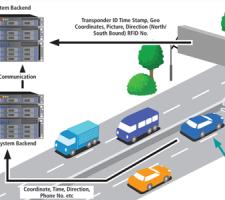
The ‘App’ screen shot examples
Jon Masters looks at a smartphone app which could be the ‘disruptive technology’ that eases the way to interoperability in tolling systems.
Consumer demand may soon drive the biggest step change yet in tolling. In the United States a new start-up company, Geotoll, has launched a smartphone app for electronic toll payment. It is not beyond possibility that rapid growth of the market for smartphones will continue – an estimated 50% of US citizens and 80% of Europeans now have one – and that the Geotoll brand will become as ubiquitous to tolling as Hoover is to vacuum cleaners.That is, if Geotoll can get universal buy-in from toll operators. The company’s chief technology officer Jaime Borras believes this to be a very real possibility. A ‘game changer’ is how Borras describes Geotoll’s offer, which he says will enhance operators’ business by raising the reliability of electronic tolling and reducing the effort expended in pursuing missed payments.
“We have not come up against any resistance. All of the agencies and operators we have spoken to are excited by the proposition of Geotoll and have said they will work with us,” Borras says.
In essence, the Geotoll app and service have been designed to augment rather than replace agencies’ existing toll collection systems. The smartphone will act as the vehicle owner’s ID tag communicating with agencies’ tag readers at toll booths while simultaneously using GPS location and cell phone networks to send its own time, place and ID information to Geotoll’s back-office. Here Geotoll’s software will verify and reconcile the toll payment, collecting funds from the user’s account and passing it on to the relevant toll authority.
Answering perceived limitation
Geotoll will guarantee the payments, Borras says, so answering a perceived limitation of smartphone toll collection. If the phone of a registered Geotoll user is switched off, has insufficient strength of signal or obscured from sending the necessary location data, a toll operator’s report of that user passing a toll gate will result in the payment being honoured.Likewise, Geotoll will collect and pass on the payments it records and the operator misses. In this way, Geotoll is being set up to be a system that would seem only likely to match or increase the percentage of toll revenues successfully collected.
All of this can be done fairly simply where toll tag reading protocols are designed to open standards, such as ISO 18000 6C. The first trials of Geotoll will start this year in States where toll systems operate to the 6C standard. Elsewhere, where proprietary standards are used, Geotoll will need the toll agency’s data reading protocols to allow its system to work in that jurisdiction.
Once given that information, Geotoll is reliant on consumer demand for its app. The offer Geotoll hopes will drive downloads and user registration is the convenience and functionality of having an automatic means of electronic payment that drivers can view and control from the smartphone screen.
“The app is very flexible. It ties to the phone number and vehicle license plate when the user registers. Account data is secured at set-up and the user can view billing information and payment history and adjust how payments are made and reported - for example as a personal use or a business expense. Each phone can hold accounts of multiple users, but the vision is for users to have one tolling account for driving anywhere in the US, therefore providing national interoperability,” Borras says.
Realising a vision
Geotoll and its vision of total interoperability (IOP) are the brainchild of the company’s chairman Wyatt Geist, founder of a number of firms as a result of his entrepreneurial development of new technologies in healthcare and other sectors. For pushing forward with Geotoll, Geist’s team of directors includes Borras and the firm’s new CEO Tim McGuckin recently recruited fromBorras himself is widely known for his work in wireless telephony. He is credited with designs of integrator circuits in the first cell phones for
Key to the functionality is communication by RFID with operators’ toll tag readers, combined with an NFC (near field communication) connection to the smartphone. Both will be achieved via Geotoll’s toll tag which is both RFID antenna and NFC transponder providing the link between the toll system and the Geotoll app.
The tag may take the form of a smartphone sleeve. Eventually, Borras says, the tag could be incorporated as hardware within smartphones, but initially it is likely to be provided as a small sticker for attaching to the back of phones to get around the problem of ensuring it can fit all shapes and sizes.
Cheaper interoperability earlier
This tag will be armed with the ‘multi-protocol’ capability that Geotoll hopes will help its system bring a step-change in interoperability.“Some toll agencies and their systems are already interoperable, but with use of multiple tag readers, which adds considerable cost. Our system will allow interoperability without having to add any further readers to toll plazas,” Borras says.
“Geotoll is interoperable with any toll system in theory. We envisage that smartphones’ GPS will be used to automatically assess and select the protocol to be used as the vehicle approaches a toll booth. The GPS will also allow the transponder and app to be turned off until the vehicle nears a toll location, so avoiding any unnecessary smartphone battery drain.”
Interoperability between toll systems is a mandate of the US Government’s MAP-21 legislation of last year, which sets a requirement for this to be reached by 2016. While most toll agencies already claim interoperability of one sort or another, the industry may not reach true nationwide interoperability until considerable time later (see sidebar).
“We appreciate that the tolling industry is enacting its own alternative ways of achieving interoperability led by organisations such as
The business model
Geotoll is targeting 5-8% market penetration within three years of launch with a single toll agency, protected by intellectual property rights secured on the smartphone app. The company is working on the revenue model for its overall toll payments system, and according to Borras, it is likely that Geotoll will charge agencies a transaction fee for assisting their toll collection efforts. The sticker tag will be sold to users at a competitive price and the app will be free of charge, “although the business model is still evolving”, he reasserts.Other details still to be finalised include a means of presenting or mounting smartphones in the car, which may mean a dashboard mounting or cradle. Certainly some way of holding the phone in view of toll operators’ tag readers is needed.
“We have developed prototypes to be tested in upcoming pilot projects,” Borras says. “Ultimately, we see the possibility for Geotoll to become a platform for paying for tolls, parking, transit tickets and other payment uses. We think that by making payment easier for users, consumer demand will drive take-up of the app and service.
“Currently when travelling across State or toll system boundaries drivers get charged more and much later as it takes agencies some time to catch up with these payments. The aim of Geotoll is to increase the convenience and efficiency of tolling accounts for consumers and operators.”













